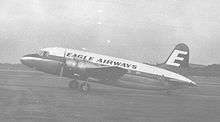1961 Holtaheia Vickers Viking crash
 A similar Vickers Viking operated by British Eagle in 1960 | |
| Accident summary | |
|---|---|
| Date | 9 August 1961 |
| Summary | Controlled flight into terrain |
| Site |
Holta, Strand, Norway 59°05′07″N 6°03′41″E / 59.08528°N 6.06139°ECoordinates: 59°05′07″N 6°03′41″E / 59.08528°N 6.06139°E |
| Passengers | 36 |
| Crew | 3 |
| Fatalities | 39 |
| Survivors | 0 |
| Aircraft type | Vickers 610 Viking 3B |
| Operator | Cunard Eagle Airways |
| Registration | G-AHPM |
| Flight origin | London Heathrow, United Kingdom |
| Destination | Stavanger Airport, Sola |
The 1961 Holtaheia Vickers Viking crash (Norwegian: Holtaheia-ulykken) was a controlled flight into terrain incident on 9 August 1961 at Holta in Strand, Norway. The Eagle Airways (later, British Eagle) Vickers 610 Viking 3B Lord Rodney was en route from London to Stavanger Airport, Sola on an AIR Tours charter flight taking a school group for a camping holiday. The aircraft was making an instrument landing when it crashed 54 km (34 mi) north east of Stavanger. The accident killed all 39 people on board.
Crash

The Viking left London at 13:29 on what was an estimated two and a half-hour charter flight.[1] Between 16:24 and 16:30 it crashed 18 nautical miles north-east of the airport on to Holteheia, a steep mountainside at an elevation of 1600 feet.[1] The crash site was 30 feet below the summit.[2]
The aircraft was destroyed and an intense fuel and oil fire followed the impact.[1] The search for the aircraft included an RAF Shackleton and Royal Norwegian Navy ships investigating the fjords in the area.[3] The wreckage was found fifteen hours after the crash by a Royal Norwegian Air Force helicopter, 15 miles east from the ILS track.
Passengers
The 36 passengers were a school class of boys aged 13 to 16 and two teachers from Lanfranc Secondary Modern School for Boys. It was at the time the deadliest aviation incident in Norway.[4][5]
Aircraft
The aircraft was a twin piston-engined Vickers 610 Viking 3B serial number 152 and registered in the United Kingdom as G-AHPM.[6] It first flew on 2 January 1947 and was delivered new to British European Airways.[6]
Investigation
The report into the crash put the cause down to "a deviation from the prescribed flight path for reasons unknown".[7]
Aftermath
33 of the boys and one teacher were buried together at a communal grave at Mitcham Road cemetery in Croydon on 17 August 1961.[8]
Ewan MacColl wrote a song, "The Young Birds," about the tragic accident.[9]
References
- Notes
- 1 2 3 World Airline Accident Summary, United Kingdom Civil Aviation Authority, 1974, ISBN 0-903083-44-2, page 17/61
- ↑ "The Queen Sends Message To Families" The Times, Friday, 11 August 1961; pg. 8
- ↑ "34 Boys in Missing Airliner" The Times, Thursday, 10 August 1961; pg. 8
- ↑ Hagir, Lise Andreassen; Oppedal, Mathias (9 August 2011). "Ein heil skuleklasse døde i flyulukka". Norwegian Broadcasting Corporation (in Norwegian). Archived from the original on 28 August 2011. Retrieved 28 August 2011.
- ↑ "9 Aug 1961". Aviation Safety Network. Archived from the original on 28 August 2011. Retrieved 28 August 2011.
- 1 2 Martin 1975, p. 19
- ↑ Flight International 4 October 1962, p. 557.
- ↑ "Thousands Line Funeral Route – 34 Air Crash Victims in Common Grave". News. The Times (55163). London. 18 August 1961. col C, p. 10.
- ↑ http://media.smithsonianfolkways.org/liner_notes/folkways/FW08734.pdf
- Bibliography
- "Stavanger Accident Report" Flight International, 4 October 1962,. p. 557.
- "The Stavanger Tragedy" Flight, 17 August 1961 p. 240,
- "Croydon remembers Lanfranc Boys after 1961 Norway air crash" BBC News 9 August 2011
- Martin, Bernard. The Viking, Valetta and Varsity. Air-Britain (Historians) Ltd. 1975. ISBN 0-85130-038-3.
- "The Lanfranc Boys" By Rosalind Jones - Published by Craigmore Publications - ISBN 978-0-9531890-3-8
- "Flystyrten i Hotaheia" By Rosalind Jones - Published by Commentum Forlag AS - ISBN 978-82-8233-052-7